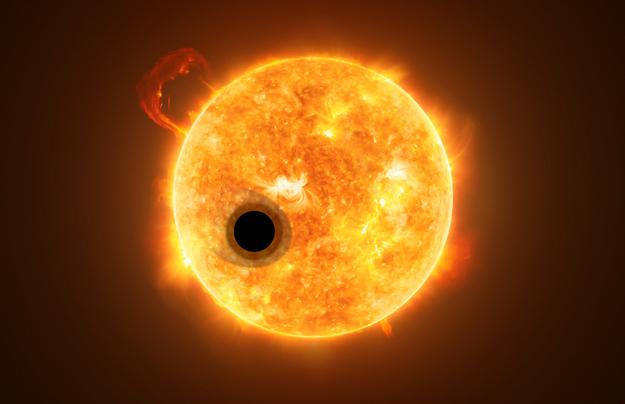

When Caroline Piaulet first started looking at an exoplanet called WASP-107b, a gas giant orbiting a star in the Virgo constellation about 212 light years away, she was mostly interested in finding out what was inside it. “I essentially wanted to get the most precise data on what the atmosphere was made of,” says Piaulet, a Ph.D student at the Université de Montréal’s Institute for Research on Exoplanets. To do that, she says, she had to first calculate its mass—a routine part of conducting transmission spectroscopy, which astronomers use to analyze the chemical makeup of exoplanets. Instead, what Piaulet found would upend what astronomers know about how some planets form. “We weren’t expecting to find what we found.”
Up until now, planet formation has tended to follow patterns we see in our own solar system. When stars form, they’re surrounded by a disc of dust and gas called a protoplanetary disc; this is the stuff that provides the building materials for what eventually becomes a planet. In classic models, based on what astronomers know about Jupiter and Saturn, gas giants need to have a solid core at least ten times as massive as the Earth to gather enough gas before the disc disappears. Without that giant core, astronomers believed, planets wouldn’t be able to build up and keep the large gas envelopes that make them gas giants.
But WASP-107b is breaking those rules: even though it’s comparable to Jupiter in size, it’s ten times lighter, bringing it closer to the mass of Neptune and making it a “super puff,” or one of the least dense exoplanets ever discovered. Piaulet concluded that the core of WASP-107b is no more than four times the mass of the Earth, which means that more than 85 percent of the planet’s mass can be found in the thick layer of gas swirling around its core. On Neptune, by comparison, the gas layer only accounts for 5 to 15 percent of its total mass.
To make matters even more complicated, WASP-107b is incredibly close to its star—over 16 times closer than the Earth is to the Sun, with an orbital period of just 5.7 days. If the planet had originally formed where it is now, explains Piaulet, there’s no way it would have become a gas giant. “To accrete enough gas to become a gas giant, it has to happen really quickly,” says Piaulet. “So it has to happen in a colder environment, which means it has to be far from the star.” WASP-107b’s existence, then, didn’t make any sense.
To explain how WASP-107b came to be, Piaulet and her team looked towards another planet—and to a theory that previously had only been applied to smaller “super puff” planets. The astronomers noticed that WASP-107c, another planet orbiting WASP-107b’s star but with a much larger orbital period of three years, had an eccentric, or oval-shaped, orbit. “That tells us something about the history of the system,” Piaulet explains. WASP-107b had most likely formed further away from its star than where it is now, and was essentially slingshotted into its current orbit by WASP-107c. While WASP-107b’s orbit normalized into a circle because of its proximity to the star, Piaulet explains WASP-107c’s eccentric orbit “kind of keeps the memory of what happened in the system.”
“This work addresses the very foundations of how giant planets can form and grow,” said Björn Benneke, Piaulet’s supervisor and an astrophysics professor at the Université de Montréal in a press release.
Now that her work establishing the mass of WASP-107b is complete, Piaulet can go back to her original goal of finding out what the planet is actually made of. But, she says, it has forever changed the way she approaches her work. “This is making me think more about the formation of the planets,” she says. “That’s not something I thought about so much before; I was focused more on the chemistry. Now I’m asking what the interior structure can tell us about the history of the planet. Mass and radius tell you much more than you would think.”
